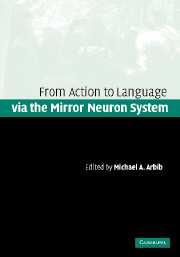Book contents
- Frontmatter
- Contents
- List of contributors
- Preface
- Part I Two perspectives
- Part II Brain, evolution, and comparative analysis
- Part III Dynamic systems in action and language
- Part IV From mirror system to syntax and Theory of Mind
- Part V Development of action and language
- 12 The development of grasping and the mirror system
- 13 Development of goal-directed imitation, object manipulation, and language in humans and robots
- 14 Assisted imitation: affordances, effectivities, and the mirror system in early language development
- 15 Implications of mirror neurons for the ontogeny and phylogeny of cultural processes: the examples of tools and language
- Index
- References
14 - Assisted imitation: affordances, effectivities, and the mirror system in early language development
Published online by Cambridge University Press: 01 September 2009
- Frontmatter
- Contents
- List of contributors
- Preface
- Part I Two perspectives
- Part II Brain, evolution, and comparative analysis
- Part III Dynamic systems in action and language
- Part IV From mirror system to syntax and Theory of Mind
- Part V Development of action and language
- 12 The development of grasping and the mirror system
- 13 Development of goal-directed imitation, object manipulation, and language in humans and robots
- 14 Assisted imitation: affordances, effectivities, and the mirror system in early language development
- 15 Implications of mirror neurons for the ontogeny and phylogeny of cultural processes: the examples of tools and language
- Index
- References
Summary
Introduction
Rizzolatti and Arbib (1998) argue in their exposition of the Mirror System Hypothesis that brain mechanisms underlying human language abilities evolved from our non-human primate ancestors' ability to link self-generated actions and similar actions of others (see Arbib, Chapter 1, this volume). On this view, communicative gestures emerged eventually from a shared understanding that actions one makes oneself are indeed like those made by conspecifics. Thus, what the self knows can be enriched by an understanding of the actions and aims of others, and vice versa. From this perspective, the origins of language reside in behaviors not originally related to communication. That is, this common understanding of action sequences may provide a “missing link” to language.
In answering the question “What are the sources from outside the self that inform what the child knows?”, the basic idea is that negotiating a shared understanding of action grounds what individuals know in common, including foregrounding the body's part in detecting that the actions of the self are “like the other.” Given this footing, what then might the evolutionary path to language and the ontogeny of language in the child have in common? This perspective roots the source of the emergence of language in both as arising from perceiving and acting, leading to gesture, and eventually to speech.
I report here on an ongoing research program designed to investigate how perceiving and acting inform achieving a consensus or common understanding of ongoing events hypothesized to underlie communicating with language.
- Type
- Chapter
- Information
- Action to Language via the Mirror Neuron System , pp. 469 - 500Publisher: Cambridge University PressPrint publication year: 2006
References
- 17
- Cited by



